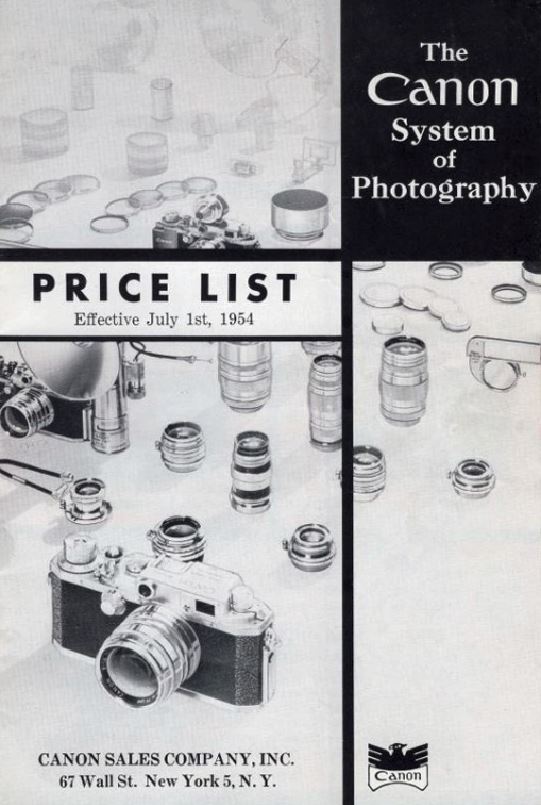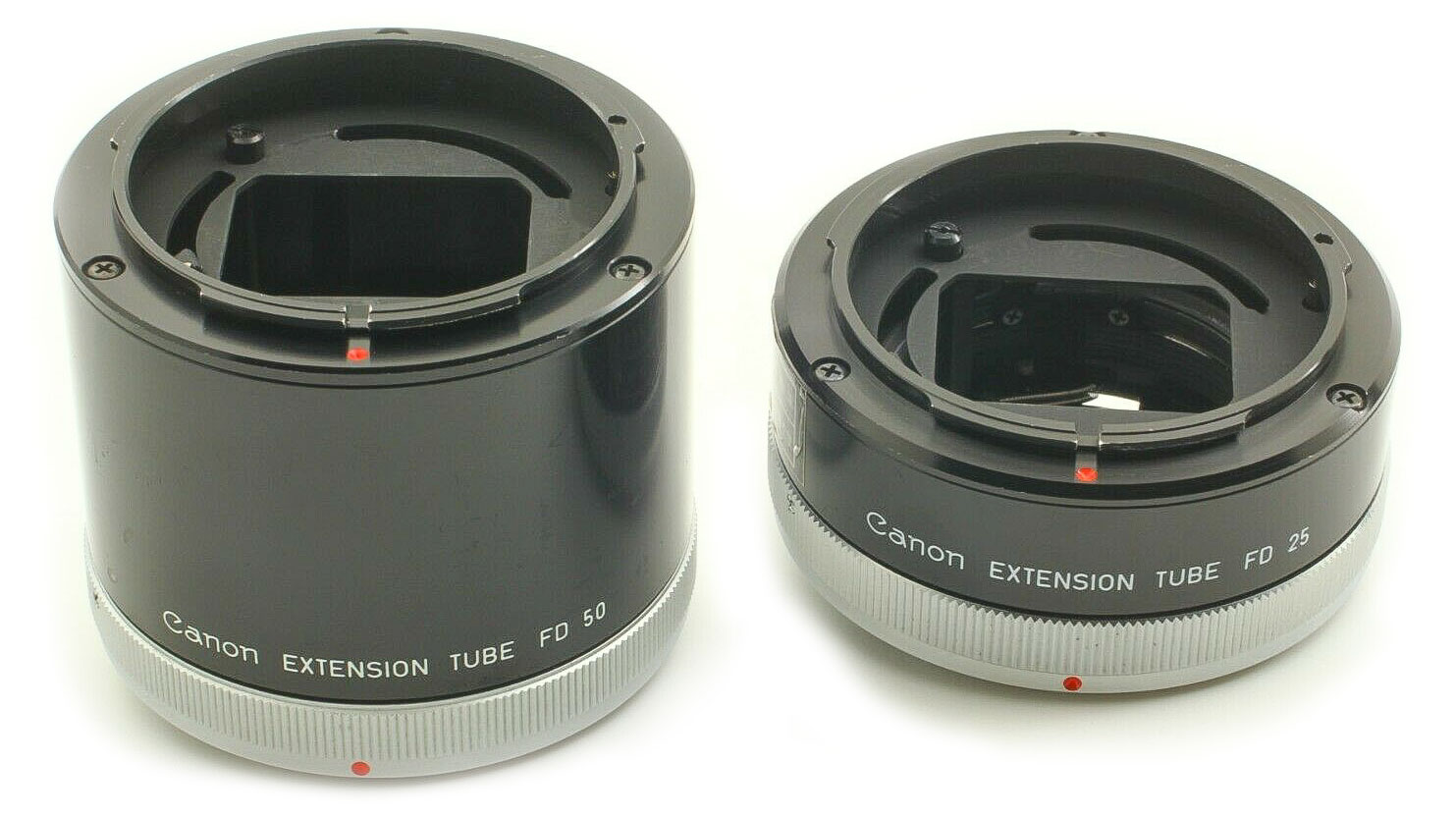This Canon FTb has a 50mm f/1.4 S.S.C. lens mounted on an M-20 Extension Tube. The M series of extension tubes do not automatically operate the diaphragm.
Extension Tubes
An extension tube is just what it says, a hollow tube that sits between lens and camera to move the lens further from the film plane. It contains no optics. However, when you move the lens further away from the film you
reduce the closest focusing
distance which allows for a
larger image.
I find very little on-line about
extension tubes except for ads
offering them for sale. I have dug into
my little library and come up with an outline of their history. However, I do
not actually have any of the early tubes and what I say here is subject to correction once I find examples and have had a chance to examine them.
There are problems with using extension tubes. Firstly, once you add distance between lens and camera the focus scales become incorrect. This is a problem for rangefinder cameras as the rangefinder does not work and you cannot rely on the distance scale on the lens. How do you focus? This explains why widespread use of extension tubes had to wait for TTL focusing.
The second problem arises from the fact that the closer the lens is to the subject the bigger the image at the film plane becomes. And that means that the light intensity falls. It falls substantially. So, unless you have TTL metering, how do you calculate the correct exposure?
And, finally, there is image quality. Lenses are designed for specific conditions. One of these conditions is that the distance from lens to film plane is small compared to the lens to subject distance. But in macro photography this is often reversed and lenses do not perform optimally. So, it is obvious we have some issues to discuss. Lets get to it!
Macrophoto Extension Tubes
The earliest reference I have found so far is in this Price List from 1 July 1954. On pages 18 1nd 19 you will find Extension Tubes in the section on copy stands. That makes sense. Because calculating focus from measurements and tables is difficult and a bit of trial and error you want distances fixed. The same goes for exposure which is equally hit and miss.
These tubes would have the M-39 thread mounts but I have no idea what they looked like. The pictures in these catalogues are not much help. It does say that there were 6 tubes of 25, 50, 75, 100, 150 and 200 mm in length.
These tubes appear again on Page 10 of the Bell & Howell/Canon Catalogue of March 1962 as accessories for the Canon Model 7 rangefinder camera. Here they are referred to as Macrophoto Extension Tubes. Pictures of the tubes are a little more helpful.
Bell and Howell / Canon Catalogue dated March 1962 has Extension Tubes described on Page 10 as accessories for the Canon Model 7.
This is my Extension Tube FL15 with its original box. The visible pin at the top right transmits diaphram trigger to the lens.
What is more interesting is the Table of Magnifications for each of the tubes which allows for the calculculation of exposure corrections. Very useful if you are using these tubes.
Now flip foward to Page 20 where accessories for the Canonflex are listed and these same Tubes are listed again along with something called the Macrophoto Coupler 58mm for coupling the 50mm f/1.8 Super-Canomatic lens to the Tubes.
There is also listed Extension Rings A, B, and C which it says are for simple macrophotography without using the Tubes or Bellows R. They are apparently 6, 9 and 12mm thicknesses. Since I don’t have any of these yet I am not certain what they are or how they work. I will report further eventually.
These Extension Rings appear again on Page 27 of the “Canon System of Photography” Brochure of March 1956.
Extension Tubes FL
In the Instruction Manual for the Canon FX at Page 46 I find the first mention I see of the Extension Tubes FL 15 and FL 25. They were designed for the FL lens mount which first made its appearance on the Canon FX followed by the FP.
These Extension Tubes sensed the movement of the diaphragm trigger and passed the signal on to the lens so the focusing could be done at full aperture.
I have tried the FL15 with FD lenses and on an FTb and A-1 and it seems to work on these cameras and lenses as well. I have not tested every combination and some others may not work Be cautious when trying unfamiliar combinations and no NOT force anything.
The Extension Tube 15mm on a Canon FP, the camera it was made for, although, it appears to function with FD lenses and FD mount F series and A series cameras.
Extension Tubes M
In the same Manual for the Canon FX at Page 46 we see an early mention of a new series of Extension Tubes, the M series. These tubes are simple spacers with no provision for automating the diaphragm in the lens. They fit easily on the Canonflex R lens mount as well as the FL and FD mounts all equally well. Each tube has an FD mount with locking ring to fit on a camera body and an FD mount for a lens on the other end.
The tubes come in three sizes, 5, 10 and 20mm allowing the user to create combinations of extension tubes that give tubes from 5mm to 55mm in 5mm incriments.
So what is the effect of usng these tubes? Here is a simple test. I put my EOS R to FD adapter on my Canon R camera. I then used various combinations of extension tubes with a 50mm f/1.4 S.S.C. lens. This is not a macro lens and it was not reversed for any of these images.
For a subject I chose a well known Doulton figure called “The Judge”. All images are full frame straight prints because we are only concerned to see the effect on magnification.
For each image the lens was set to its closest focusing distance of 0.45 meters so the magnification is due solely to the extension tube arrangement. The tubes have no auto aperture feature so the shutter and aperture were handled manually which is a bit awkward but not impossible.
The Extension Tubes M Set is a versitile tool for closeup photography. It is easy to use on modern digital cameras with the right converter and R, FL, FD or FDn lenses. The diaphragm will be manual but in macro photography that is not a huge problem. The range of extensions, if you take into account the focusing movement of the lens, is continuous from 5mm to 50mm. A bellows unit may give you more but at 55mm you begin to have serious problems with normal lenses. At that point you have to consider using much more specialized equipment.

The Canon Life Size Adapter
The Canon Life Size Adapter was just an extension tube which Canon said was specifically for the FD 50mm f/3.5 S.S.C. macro lens. However, it was just an extension tube and functioned exactly like the FD M-20.
I don’t have one of these but I will find one eventually. They are not expensive but to buy one on E-bay means paying for postage that is twice the cost of the extension tube. I have trouble doing that.
The FD Extension Tubes are still just spacers. But these offer auto diaphragm function. However, the sizes do not give such fine gradations at the Extension Tubes M.
You can see in the pictures here the connecting links that transfer communication between lens and camera. These allow the camera TTL metering to function at full aperture and the lens to stop down automatically for the exposure. A definite convenience for macro photogaphy.
Only two tubes are shown in the picture but there are three in the set, 15mm, 25mm, and 50mm. All will work with FL, FD, or FDn lenses. Because most lenses are not designed for close-up work and so they have performance issues. The best results are obtained with dedicated macro lenses such as the FLM 50mm f/3.5, the FDM 50mm f/3.5 S.S.C., the FDM 100mm f/4.0 S.C., the New Macro FD 50mm f/3.5 or the New Macro FD 50mm f/4.0.
The Instruction Sheet that comes with the FD 25-U and FD 50-U is not very instructive but it does contain tables for exposure compensation and focus distances.
This website is the work of R. Flynn Marr who is solely responsible for its contents which are subject to his claim of copyright. User Manuals, Brochures and Advertising Materials of Canon and other manufacturers available on this site are subject to the copyright claims and are the property of Canon and other manufacturers and they are offered here for personal use only.




















